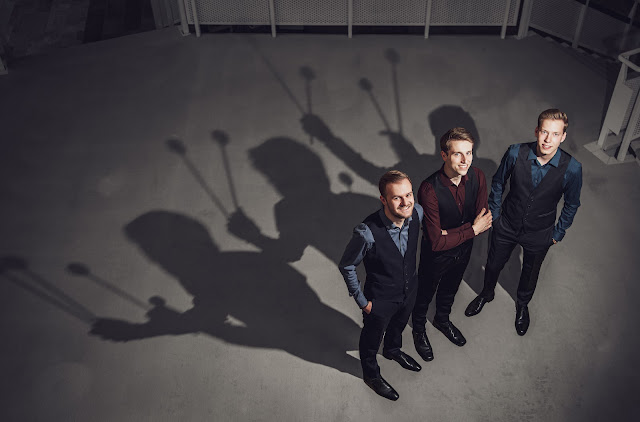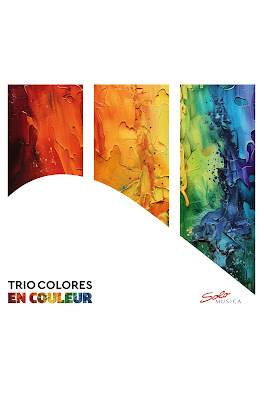En Couleur: Saint-Saens, Ravel, Tailleferre, Debussy, Milhaud; Trio Colores (Fabian Ziegler, Luca Staffelbach and Matthias Kessper); Solo Musica
Reviewed 7 October 2024
Sensitivity of touch and an ear for timbre and colour bring a sense of timbral magical to these reinventions of French music for a group playing marimbas, vibraphones and glockenspiels
The art of a good transcription is to reinvent the original in a way which remains true but exploits all the characteristics of the new genre. Sometimes this can be radical and sometimes quite discreet; playing much of Bach’s keyboard music on the piano requires only minor adjustment whereas Busoni’s piano transcription of the Chaconne from Violin Partita No. 2 has a significant amount of Busoni added to the Bach. How could it not, as the original was for a single instrumental line with harmony just touched in.
On this new disc, En Couleur on Solo Musica from Trio Colores (Fabian Ziegler, Luca Staffelbach and Matthias Kessper, mallett percussion) we have Saint-Saens’ Danse Macbre, Maurice Ravel’s Le Tombeau de Couperin, Germainne Tailleferre’s Toccata, Debussy’s Petite Suite and Daius Milhaud’s Scaramouche transcribed for a trio playing two marimbas, three vibraphones and two glockenspeils. This is the debut CD of a trio founded at Zürcher Hochschule der Künste (Zurich University of the Arts) by three Swiss and Austrian musicians.
They begin with Saint-Saens’ Danse Macabre which seems predestined for performance on mallet-played percussion, but the trio confounds expectations with an opening that shimmers wonderfully before we get the familiar tune, and yes we can imagine skeletons clicking but beyond this, the group’s sense of colour is completely magical.
When we move on to Ravel’s Le Tombeau de Couperin (transcribing all six movements of the piano original) what we admire is the way the trio acts as one single huge whole. The Prelude shimmers as the three dazzle with the fast notes, whilst the Fugue has a sense of timbre that makes it rather otherworldly (this was one of the movements Ravel did not transcribe for orchestra). Forlane combines colour with a nice swing to it, whilst Rigaudon makes the most of those mallets in a finely rhythmic account of the movement. Menuet is delicate, whilst Toccata gives vent to all those mallet percussion opportunities. Colour and timbre are to the fore in these magical transcriptions, we move further away from Ravel’s 18th century inspirations, but the trio take full advantage of their instruments’ possibilities.
Next comes a short Toccata by Germaine Tailleferre, a bon-bouche that is almost gamlan-like in its atmosphere. This is followed by Debussy’s Petite Suite, originally written for piano four hands. En Bateau is delicate and rather original in its wonderful sound world, the piano is a long way away, but the music is a lovely evocation of Debussy’s original. Cortege and Menuet are equally delicate and light, the players revelling in high, transparent timbres and a real lightness of touch, creating an airyness that would be the envy of many pianists. The final Ballet introduces a nicely perky approach to rhythm.
Finally comes Milhaud’s Scaramouche, a three movement written for piano duet in 1937. Vif is just that, fast, vivid and full of jangly sounds, enchanting. Then Modere slows things down but keeps us being enchanted with its haunting melody, and finally the best known movement, Brazileira where all the rhythmic impetus implied by the Brazilian origins of the piece come out.
This is a completely magical disc. The trio find the wonder in the
colours and timbres of a huge range of sounds, and each movement of each
work is not only enchanting but takes us on a journey into different
aspects of the composers’ originals.
Founded in 2017, the group
clearly is one to watch. They have commissioned a triple concerto from
Avner Dorman which they will premiere in January 2025 with Staatstheater
Braunschweig.
 |
| Trio Colores (Photo: Clara Evens) |
Camille Saint-Saens – Danse Macabre
Maurice Ravel – Le Tombeau de Couperin
Germaine Tailleferre – Toccata
Claude Debussy – Petite Suite
Darius Milhaud – Scaramouche
Trio Colores (Fabian Ziegler, Luca Staffelbach, Matthias Kessler, mallet percussion)
Recorded 18-21 April and 14-17 August 2023, Angelika Kauffmann Saal, Schwarzenberg
SOLO MUSICA SM 467 1CD [61:37]
The blog is free, but I’d be delighted if you were to show your appreciation by buying me a coffee.
Elsewhere on this blog
- From expressionist nightmare to radiant energy: Schoenberg’s Pierrot Lunaire & Schubert’s String Quintet at Hatfield – concert review
- Charpentier’s Actéon & Rameau’s Pygmalion: a perfect double-bill offering a delightful, entertaining evening – opera review
- Intimate & communicative: Solomon’s Knot brings its distinctive approach to Monteverdi’s Vespers of 1610 at Wigmore Hall – concert review
- Waiting till they feel they have something to say: I chat to Trio Bohémo about their debut disc – interview
- On tour from New York, the Philip Glass Ensemble stopped off in Cambridge in a presentation by the Cambridge Music Festival – concert review
- Everyone clearly enjoyed themselves & brought the house down: The Sixteen in Monteverdi’s Vespers of 1610 at Temple Church – concert review
- Une messe imaginaire: Bruckner & Frank Martin from Lyon – record review
- What lies beneath: a brilliant reinvention of Judith Weir’s Blond Eckbert at the heart of ETO’s exploration of German Romanticism – opera review
- A glorious noise: from one to eight choirs in I Fagiolini’s evening of music from 17th-century Venice and Rome – concert review
- After the humans are gone, the instruments still sing and it is important to listen – Jake Heggie on his song cycle, Intonations: Songs from the Violins of Hope – interview
- Home











